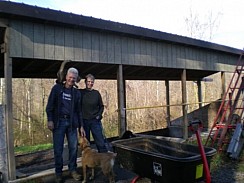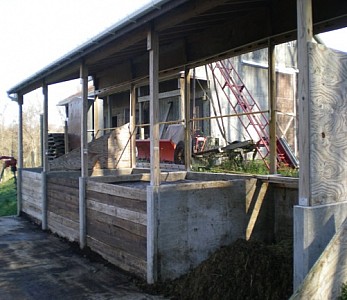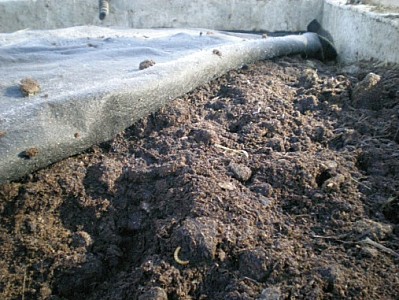October 21, 2013
Integrating composting practices into farming operations and refining compost production and utilization methods can help farmers better manage farm organic waste, including manure and crop residues. The resulting compost can be applied for on-farm soil benefits and/or sold as a valued-added product. To expand and support farm-based compost markets in the Northeast, NERC was awarded a grant from the Northeast Sustainable Agriculture Research and Education (SARE) program. Resources developed by NERC for the project, as well as presentations from seven compost marketing workshops, are posted on NERC’s website. NERC provided technical assistance to farm compost operations, including development of operation-specific marketing plans.
Today’s blog features another case study of a farm compost operation which participated in NERC’s project—Fern Hill Compost in Red Creek, New York.
Overview
 Fern Hill Compost started as the manure management system for Fern Hill Farm, an operation that breeds Thoroughbred horses for racing. The horse operation had generated a large accumulation of manure which, not being the primary focus of the farm, simply decomposed into the earth with little management. The farm proprietors, the Spaldings, however, became concerned with the environmental impact of uncontrolled manure decomposition on the ecosystem.
Fern Hill Compost started as the manure management system for Fern Hill Farm, an operation that breeds Thoroughbred horses for racing. The horse operation had generated a large accumulation of manure which, not being the primary focus of the farm, simply decomposed into the earth with little management. The farm proprietors, the Spaldings, however, became concerned with the environmental impact of uncontrolled manure decomposition on the ecosystem.
After consulting with the firm of O2Compost, a composting facility was constructed in the summer of 2009, adjacent to the farm’s horse barn. The facility was designed with excess capacity in order to expand the farm operation by collecting manure and bedding from other small horse-keeping operations in the area. Fern Hill Compost was born and began a container service with a limited number of clients.
Through proper management of the organics composting process, Fern Hill Compost was able to maximize the benefits of using its farm generated manure and bedding to manufacture compost, while maintaining a very clean and healthy equine operation. The farm and other area horse operations that used Fern Hill’s manure removal services realized the positive environmental benefits for their horse-keeping operations—reduced smells, fly populations, leachate in waterways, and reduced parasites and pathogens in their operations.
 Moreover, the Fern Hill Farm used the resulting compost as a soil amendment and realized the value of creating a value-added product to increase farm revenues. The excess product was bagged and sold to garden centers and marketed through word-of-mouth.
Moreover, the Fern Hill Farm used the resulting compost as a soil amendment and realized the value of creating a value-added product to increase farm revenues. The excess product was bagged and sold to garden centers and marketed through word-of-mouth.
Materials Composted
Horse manure and bedding is the feedstock used to make Fern Hill Compost. According to the Fern Hill Compost proprietor, “as compost feedstock goes, you can hardly find anything better than equine stall waste. The nutritional values of the resultant compost are higher than that made from most any other feedstock (typically twice the nitrogen of dairy manure), the carbon to nitrogen ratio is ideal, the porosity allows for effective aeration without additional bulking agents, and the moisture content is well within an easy range to compost.”
 To ensure the high quality and purity of its compost, Fern Hill knows the quality of the diet fed to its own horses and has established a good relationship with horse owners provided collection services in order to know the diet of the animals and to ensure that contaminants, such as plastics, do not get tossed into the stall waste.
To ensure the high quality and purity of its compost, Fern Hill knows the quality of the diet fed to its own horses and has established a good relationship with horse owners provided collection services in order to know the diet of the animals and to ensure that contaminants, such as plastics, do not get tossed into the stall waste.
Compost Method and Equipment
Fern Hill Compost begins with the collection of horse stable waste, including urine, feces, and bedding (sawdust, wood shavings, and/or straw). Horse operations that sign onto the Fern Hill collection services receive one or more one-cubic yard polyethylene bins for cleaning out stall waste. Fern Hill provided weekly collection, including pressure washing and sanitizing the bins at the respective farms. Stall waste from the Fern Hill Farm horse operation is collected daily, using a pitch fork and wheelbarrow.
 This material generally has the correct carbon to nitrogen ratio for composting. The material is mixed and fluffed to improve porosity, and water added as needed to adjust the moisture content of the material to 60%. The material is then composted in three, 10-cubic yard bunkers for aerated static pile composting. The system contains PVC piping, laid into flooring of the bunkers, which is connected to an electric blower system designed to effectively aerate the composting organics. The blower cycles on and off 24 hours a day with the objective of maintaining the materials at temperature of 131° F, or higher, for a minimum of three days to sufficiently destroy any pathogens and weed seeds and promote rapid decomposition.
This material generally has the correct carbon to nitrogen ratio for composting. The material is mixed and fluffed to improve porosity, and water added as needed to adjust the moisture content of the material to 60%. The material is then composted in three, 10-cubic yard bunkers for aerated static pile composting. The system contains PVC piping, laid into flooring of the bunkers, which is connected to an electric blower system designed to effectively aerate the composting organics. The blower cycles on and off 24 hours a day with the objective of maintaining the materials at temperature of 131° F, or higher, for a minimum of three days to sufficiently destroy any pathogens and weed seeds and promote rapid decomposition.

Controlled by pile temperature, timers, and delivery valves, the proper oxygen level is maintained throughout a 30-day active composting process. The bunkers have concrete retainer and divider walls. A roof covers all bays to keep rain and snow off the pile and to provide shade during the summer months. The material in each bin is also protected with a special compost cover fabric which aids in moisture, temperature, and odor control.
Feedstock and temperatures are closely monitored. Temperatures are recorded from multiple sample points within the piles to assure uniformity and that pasteurizing conditions are attained. Typical temperatures will run as high as 160° F, remain above 131° F for a minimum of three days, and then drop into the 100° F – 110° F range. These temperatures are sufficient to kill pathogens and weed seeds, but not the beneficial microbes needed to decompose the organic material.
Each composting cell has a water addition system to adjust moisture level in the feedstock, as well as a leachate collection system in the floor to allow any liquid that drains out of the pile to be returned to the cell, rather than leaching to the environment. Every 7 - 10 days during the active stage of composting, the material is removed, remixed, and placed in another cell, where thermophilic temperatures for active composting are once again maintained.
 After the active composting stage, the material is removed, and processed through a hammermill in order to grind the cellulosic and lignin components and moved to a curing pad under a breathable yet water-shedding fabric cover. The material is stored for a minimum of two months in order to properly cure. In-house testing is done to assure a stable and mature product prior to packaging.
After the active composting stage, the material is removed, and processed through a hammermill in order to grind the cellulosic and lignin components and moved to a curing pad under a breathable yet water-shedding fabric cover. The material is stored for a minimum of two months in order to properly cure. In-house testing is done to assure a stable and mature product prior to packaging.
Marketing
Fern Hill Compost effectively promotes the value of compost as a soil amendment through its website marketing and customer education. Its marketing not only promotes the benefits of compost, but effectively focusses on Fern Hill Compost products and what sets Fern Hill Compost and its quality feedstocks apart from other composts.

Additional market capacity building and strategies include:
- Designing an appropriate compost operation with compost consultant.
- Designed to meet on-farm manure management needs, compost product marketing goals, and to provide for extra feedstock capacity to provide services for other equine operations and bring in additional revenues through collection of off-site feedstock.
- Extensive literature review and research on compost businesses, techniques, operations, and sales strategies.
- Researching compost marketing techniques.
- Attended NERC compost marketing workshop, 2010.
- Consulting with compost experts, on pricing, packaging labels, etc.
- Researching and testing appropriate packaging to meet the needs of customers.
- Researching area compost products, how sold, pricing, etc.
- Effective use of word-of-mouth to promote the product and establishing a presence at garden shows, farmers markets, festivals, and other events to achieve greater visibility.
- Heavy use of low cost, effective social media and website to promote product and e-commerce, with establishment of a Facebook page in February 2011, regular postings and use of Twitter.
- Effective use of the Fern Hill Compost website, established in March 2011, as an educational tool for selling compost and to meet targeted customer needs; specific information on Fern Hill Compost and its specific benefits, and uses of compost.
Compost Utilization, Customer Base, and Sales
One cubic yard dumpsters for collection of manure and weekly pickup service are provided to horse operation customers. A collection fee of $48 a month for one bin and $28 per month for second bin is charged.
Fern Hill Compost products include:
- Bulk compost
- Bagged compost in 1 cubic-feet, 35 pound bags
- Premium select compost, 7 liter bag
- Value pack: Two, 7 liter bags
The Fern Hill proprietor sells packaged and bulk product at the Central New York Regional Market in Syracuse. Fern Hill compost is also marketed through local farmers markets, garden centers, hardware stores, and other retail outlets.
Challenges and Solutions
Challenge: Developing a business model for composting on-farm manure in a cost-effective and environmentally-sound manner.
Solution: Developing a sound foundation in the composting business through research and consultation with experts; attending compost marketing workshop and researching effective marketing techniques; and, application of gained knowledge in design, construction, and operation of compost system.
Challenge: Stall cleaning for the farms being serviced would freeze in the poly-containers, making emptying them into the collection vehicle difficult.
Solution: Applying a release agent to the inside of the bags after emptying and cleaning them. The release agent formula was developed from a beet juice and vegetable oil base for ice melting and non-sticking qualities respectively.
Challenge: Building a successful compost operation that will supply sufficient revenues for a sustaining family income.
Solution: A temporary solution was to undertake a full-time off-farm employment position.
For the complete case study of Fern Hill Compost see NERC’s website.


Comments (0)
Add a Comment